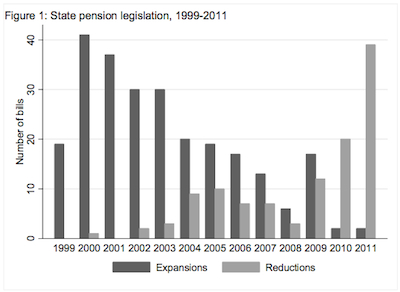(September 10, 2013) – It may be hard to believe, but according to legislative voting records, public pensions only became a partisan issue a few years ago.
A study of state lawmakers’ voting records from 1999 through 2011 has determined that Democrats and Republicans heavily supported expanding pension benefits until 2009. During the first three years of the data set, 34 states passed bills boosting liabilities, while just a single state—South Dakota—reduced benefits.
But the financial crisis brought an end to both this largesse and political consensus, the researchers found.
Sarah Anzia, a public policy scholar at the University of California, Berkeley, and Terry Moe, a senior fellow at the conservative-leaning Hoover Institution, authored the paper. Their study analyzed the fate of 366 bills adopted by lawmakers in 49 states, leaving out Nebraska because it has a nonpartisan legislature.
Each bill either increased public pension benefits or curtailed them. Those impacting very small numbers of people were excluded.
Prior to 2009, Democrats voted to raise benefits 97% of the time, while Republicans supported increases at a rate of 92%. Democrats’ rate held steady (98%) with the onset of the recession, while Republican “yes” votes fell to 68%, according to 34,301-vote data set.
Likewise, before the recession, politicians of both parties tended to back the rare pension reduction bills that crossed their desks roughly 90% of the time. Post-2008, voting became much more partisan. Republicans serving in Democratically controlled states supported reforms at a rate of 54%. When Democrats were in the minority, “yes” votes fell to 69%. Politicians from both sides of the aisle continued to support reductions more than 90% of the time when their own party was in power.
Typically, politicians “are in the enviable position of being able to promise public workers and their unions much-valued benefits without having to pay the true costs,” Moe and Anzia argue. “This is an alluring political calculus that knows no party lines.”
With arrival of the recession, however, “pensions became a salient, much-publicized issue,” the authors wrote. “This was a new political environment. And with the change in environment came a change in incentives.”
One of these incentives, the authors contended, was campaign financing. Union support made little difference in voting records before the crisis—the data showed lawmakers of both stripes supporting nearly any bill that boosted pensions.
Following 2008, however, Republicans who had received donations from public sector unions were 15 percentage points more likely to vote for benefit increases than those who hadn’t. Similarly, the study found that Democratic support for Republican-led reform bills dropped by 8 percentage points when Democrats had accepted union money.
Partisan disagreements erupted after the recession over how to curb retirement liabilities, but blue and red states alike agreed that something had to be done. Out of 63 pension bills passed in 2010 and 2011, 59 of them cut benefits, according to the paper.
However, the authors concluded, political incentives still rewarded short-termism:
“Governments were faced with fiscal crises that demanded huge new pension contributions and basic reforms, and these crises needed to be overcome,” Moe and Anzia wrote. Still, “their incentives were to be responsive to their constituents but to get beyond the immediate crises with as little political pain as possible—which usually meant that they continued to push costs into the future for other politicians and taxpayers to deal with.”
Graph courtesy of Anzia and Moe. Their full paper is available here.

Related Content: Red State? Blue State? Underfunded State
